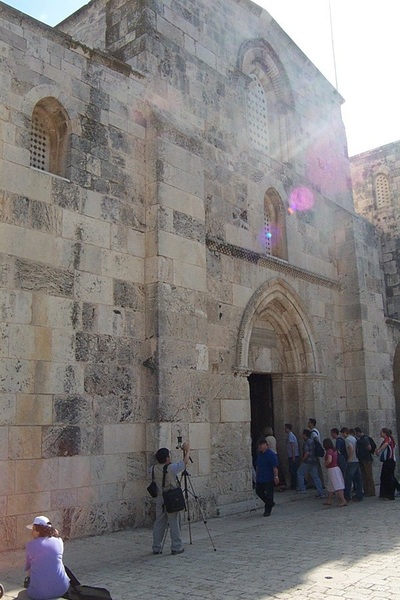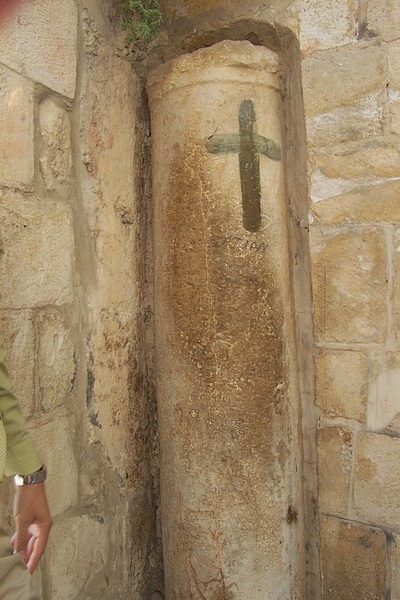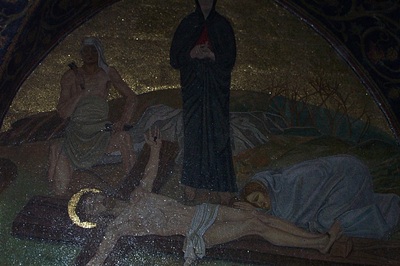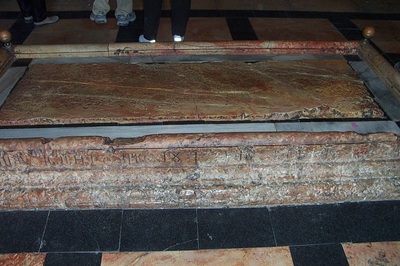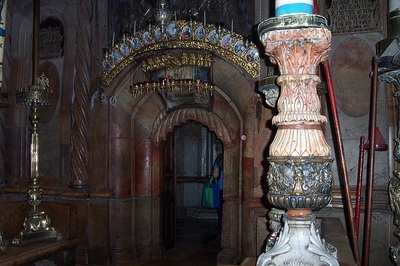November 8, 2004: Jerusalem - The Old City
Monday, November 8, 2004
We departed after our traditional hotel breakfast for our trip to the old city of Jerusalem. We entered the city through the Dung Gate. The name comes from the fact that the people of Jerusalem brought their garbage out this gate to be transported to the Gahenna Valley for burning. We had to separate into two lines, one for the men and one for the women to pass through the metal detectors.
The first stop was at the Wailing Wall. This wall is all that remains of Herod's Temple - a small portion of the foundation. It is at this wall that Jews come to offer their prayers. Some rock back and forth as they pray at the foot of the wall, others sit on benches and read, others pass into a library for study. There are thousands of small pieces of paper stuck into the wall. Each piece of paper is a prayer.
We walked up the ramp to the Temple Mount - the site of the former Temple. Today all this area is dedicated as a Muslim mosque. Christians are not allowed to enter the buildings and are only allowed on the grounds for certain periods of the day. We viewed the beautifully ornate Dome of the Rock. This shrine is said to cover the very rock on which Muslims believe that Abraham would have sacrificed his son, Ishmael. Before this building was converted into a mosque, it was a church which covered the same rock, only the Christians believed the rock to be the one on which Abraham would have offered his other son Isaac. The area has been fought over for centuries. The dome is covered with 24 karat gold and gleams brightly in the sunlight. As we walked out of the temple area we passed the open windows of a Muslim training school. The sounds of the children echoed throughout the area. Also inside the temple area is a large fountain surrounded by benches. Muslims sit at the foot of the temple and wash their feet, their hands, their forehead and behind their ears before they enter the Mosque.
We walked past the inside of the Golden Gate - the gate through which Jesus walked between the Garden of Gethsemane and Jerusalem. This gate is now blocked in to prevent entrance to the temple area.
We walked through the Sheep Gate to see the pool of Bethesda. The pool is two large rectangles that would have been filled with water. What surprised us was the depth - over 30 feet. Churches were built over the pool and then destroyed. The Christians and the Muslims have been fighting over this land for centuries. The churches over the pools have been destroyed. However, next to the pool is the Church of St. Anne. This church was built by Crusaders and is cared for by the French "White Fathers" - an order that does humanitarian work throughout the world. We met Father Michael who maintains the church. This church is built on the traditional spot of the birth of Mary, the mother of Jesus. It is named after Mary's mother, Anne. We visited the crypt that marks the spot.
We then entered the Antonio Fortress, named for Marc Anthony by King Herod who built this large fortress to protect the city. It is in this building that Pilate judged Jesus. We walked across the tiles upon which Jesus would have walked. In one of the floor tiles was etched the outline for a game called, "The King's Game." This game involved throwing dice to determine who would remain - similar to today's TV shows. This would also be the place where the soldiers cast their dice for the clothes of Jesus.
We then started our walk on the "Via Dolorosa" - The Way of Sorrows. This is the traditional path walked by Jesus as He carried His cross to Calvary.
Station 1 is located in the courtyard of what is now Omariye College - a school for Muslim children. It is here that Jesus was condemned to death.
Station 2 is located in the Chapels of the Condemnation and Flagellation. It is at this place that Jesus was clothed with purple, mocked and whipped.
Station 3 is out in the street and marks where it is believed that Jesus fell with the cross. Station 4 is where Jesus talked to Mary, His mother.
Station 5 is marked by a Franciscan chapel and commemorates the place where Simon the Cyrenian was forced to carry the cross. We passed by stations 6, 7, and 9. These stations are traditional stations for the Catholic faith but not universally celebrated by the Lutherans. Station 8 is marked by a Latin Cross on the wall of a Greek monastery and is the traditional spot where Jesus consoled the women of Jerusalem.
We then entered the Church of the Holy Sepulchre. We visited the spot where Jesus was stripped of His garments. We ascended the steps to station 11, the place where Jesus was nailed to the cross. Next to this chapel is the 12th station - where Jesus died on the cross. This area is controlled by the Greek Orthodox Christians. They have built an altar over an outcropping of rock. Under the altar is a metal covering with a hole cut in the center. We could place our arm into the hole and feel the rock of Mount Calvary. It was peaceful to feel this rock.
We walked down the steps to a flat area with a large marble slab - station 13. It is this area where Jesus was laid after He was taken down from the cross. There is a large marble slab marking this place. The marble smells very sweet because pilgrims come and anoint the rock with spices - to symbolize the spices the women would have poured on Jesus after He was taken down from the cross.
Station 14 is the tomb, the traditional spot where Jesus was laid after His death. It was very emotional to touch the empty shelf where Jesus was laid. A very ornate banner hung over the slab with the words, "Khristos Anestay" - Greek for "Christ is risen!"
The Church of the Holy Sepulcher is very large. It was built to cover all of the traditional areas of the death, burial and resurrection of Jesus. Since so many Christian denominations claim rights to the holy sites, the church"s sections and sites are governed and controlled by 6 different denominations - Roman Catholic, Eastern Orthodox Catholic, Armenian Catholic, Coptic, Ethiopian Christians, and Syrian Orthodox. This means that there are many different forms of artwork, sculpture, and decoration to see. It is one of the most beautiful churches I have ever seen.
We then walked to our restaurant for lunch. We ate at the Everest Cafeteria - a small kitchen with tables under umbrellas out into the street. We ate gyro sandwiches and had Coke to drink. We ate Baklava for dessert. Baklava is a small pastry filled with sweet sugar, syrup and nuts. After lunch we drank small cups of Turkish coffee - very strong and very good.
After a short shopping stop, we entered the Church of the Holy Sepulchre again. This time we were escorted past the public areas into the Crusader Chapel. This chapel was built by the Crusaders. It was in this chapel that Rev. Ken Klaus recorded his Easter sermon for "The Lutheran Hour." He stood on a small platform under a beautiful carved figure of the risen Christ. He preached a very powerful Easter message - made even more emotional by being at the traditional spot where Christ suffered, died, buried and rose for us - for our sins. You will be able to hear this sermon at Easter, 2005.
We left the city through the Joppa Gate, named because it was on the road to Joppa. We drove to the Garden Tomb. This spot developed as an alternative spot for Calvary and the tomb. The garden and tomb looked very similar to the pictures we have seen for years depicting the tomb.
Regardless of whether or not we stood on the exact spot where Jesus stood is not as important as the fact that Jesus did walk here on earth. He did preach. He did heal the sick. He did suffer under Pontius Pilate. He was nailed to the cross. He did die. He was buried. He did rise on the third day. He lives now - forever.
We arrived back at the hotel drained emotionally and physically. The day was filled with strong emotions. We walked the narrow streets of old Jerusalem city. We were approached by children, beggars and thieves. We smelled wonderful smells of food and coffee. We smelled the stench of garbage in the streets. We heard a multitude of languages. We were surrounded by armed soldiers. We worshipped in the churches. We celebrated at the tomb. We felt as if we were in Jerusalem at the time of Christ.
Tomorrow we head north.
We departed after our traditional hotel breakfast for our trip to the old city of Jerusalem. We entered the city through the Dung Gate. The name comes from the fact that the people of Jerusalem brought their garbage out this gate to be transported to the Gahenna Valley for burning. We had to separate into two lines, one for the men and one for the women to pass through the metal detectors.
The first stop was at the Wailing Wall. This wall is all that remains of Herod's Temple - a small portion of the foundation. It is at this wall that Jews come to offer their prayers. Some rock back and forth as they pray at the foot of the wall, others sit on benches and read, others pass into a library for study. There are thousands of small pieces of paper stuck into the wall. Each piece of paper is a prayer.
We walked up the ramp to the Temple Mount - the site of the former Temple. Today all this area is dedicated as a Muslim mosque. Christians are not allowed to enter the buildings and are only allowed on the grounds for certain periods of the day. We viewed the beautifully ornate Dome of the Rock. This shrine is said to cover the very rock on which Muslims believe that Abraham would have sacrificed his son, Ishmael. Before this building was converted into a mosque, it was a church which covered the same rock, only the Christians believed the rock to be the one on which Abraham would have offered his other son Isaac. The area has been fought over for centuries. The dome is covered with 24 karat gold and gleams brightly in the sunlight. As we walked out of the temple area we passed the open windows of a Muslim training school. The sounds of the children echoed throughout the area. Also inside the temple area is a large fountain surrounded by benches. Muslims sit at the foot of the temple and wash their feet, their hands, their forehead and behind their ears before they enter the Mosque.
We walked past the inside of the Golden Gate - the gate through which Jesus walked between the Garden of Gethsemane and Jerusalem. This gate is now blocked in to prevent entrance to the temple area.
We walked through the Sheep Gate to see the pool of Bethesda. The pool is two large rectangles that would have been filled with water. What surprised us was the depth - over 30 feet. Churches were built over the pool and then destroyed. The Christians and the Muslims have been fighting over this land for centuries. The churches over the pools have been destroyed. However, next to the pool is the Church of St. Anne. This church was built by Crusaders and is cared for by the French "White Fathers" - an order that does humanitarian work throughout the world. We met Father Michael who maintains the church. This church is built on the traditional spot of the birth of Mary, the mother of Jesus. It is named after Mary's mother, Anne. We visited the crypt that marks the spot.
We then entered the Antonio Fortress, named for Marc Anthony by King Herod who built this large fortress to protect the city. It is in this building that Pilate judged Jesus. We walked across the tiles upon which Jesus would have walked. In one of the floor tiles was etched the outline for a game called, "The King's Game." This game involved throwing dice to determine who would remain - similar to today's TV shows. This would also be the place where the soldiers cast their dice for the clothes of Jesus.
We then started our walk on the "Via Dolorosa" - The Way of Sorrows. This is the traditional path walked by Jesus as He carried His cross to Calvary.
Station 1 is located in the courtyard of what is now Omariye College - a school for Muslim children. It is here that Jesus was condemned to death.
Station 2 is located in the Chapels of the Condemnation and Flagellation. It is at this place that Jesus was clothed with purple, mocked and whipped.
Station 3 is out in the street and marks where it is believed that Jesus fell with the cross. Station 4 is where Jesus talked to Mary, His mother.
Station 5 is marked by a Franciscan chapel and commemorates the place where Simon the Cyrenian was forced to carry the cross. We passed by stations 6, 7, and 9. These stations are traditional stations for the Catholic faith but not universally celebrated by the Lutherans. Station 8 is marked by a Latin Cross on the wall of a Greek monastery and is the traditional spot where Jesus consoled the women of Jerusalem.
We then entered the Church of the Holy Sepulchre. We visited the spot where Jesus was stripped of His garments. We ascended the steps to station 11, the place where Jesus was nailed to the cross. Next to this chapel is the 12th station - where Jesus died on the cross. This area is controlled by the Greek Orthodox Christians. They have built an altar over an outcropping of rock. Under the altar is a metal covering with a hole cut in the center. We could place our arm into the hole and feel the rock of Mount Calvary. It was peaceful to feel this rock.
We walked down the steps to a flat area with a large marble slab - station 13. It is this area where Jesus was laid after He was taken down from the cross. There is a large marble slab marking this place. The marble smells very sweet because pilgrims come and anoint the rock with spices - to symbolize the spices the women would have poured on Jesus after He was taken down from the cross.
Station 14 is the tomb, the traditional spot where Jesus was laid after His death. It was very emotional to touch the empty shelf where Jesus was laid. A very ornate banner hung over the slab with the words, "Khristos Anestay" - Greek for "Christ is risen!"
The Church of the Holy Sepulcher is very large. It was built to cover all of the traditional areas of the death, burial and resurrection of Jesus. Since so many Christian denominations claim rights to the holy sites, the church"s sections and sites are governed and controlled by 6 different denominations - Roman Catholic, Eastern Orthodox Catholic, Armenian Catholic, Coptic, Ethiopian Christians, and Syrian Orthodox. This means that there are many different forms of artwork, sculpture, and decoration to see. It is one of the most beautiful churches I have ever seen.
We then walked to our restaurant for lunch. We ate at the Everest Cafeteria - a small kitchen with tables under umbrellas out into the street. We ate gyro sandwiches and had Coke to drink. We ate Baklava for dessert. Baklava is a small pastry filled with sweet sugar, syrup and nuts. After lunch we drank small cups of Turkish coffee - very strong and very good.
After a short shopping stop, we entered the Church of the Holy Sepulchre again. This time we were escorted past the public areas into the Crusader Chapel. This chapel was built by the Crusaders. It was in this chapel that Rev. Ken Klaus recorded his Easter sermon for "The Lutheran Hour." He stood on a small platform under a beautiful carved figure of the risen Christ. He preached a very powerful Easter message - made even more emotional by being at the traditional spot where Christ suffered, died, buried and rose for us - for our sins. You will be able to hear this sermon at Easter, 2005.
We left the city through the Joppa Gate, named because it was on the road to Joppa. We drove to the Garden Tomb. This spot developed as an alternative spot for Calvary and the tomb. The garden and tomb looked very similar to the pictures we have seen for years depicting the tomb.
Regardless of whether or not we stood on the exact spot where Jesus stood is not as important as the fact that Jesus did walk here on earth. He did preach. He did heal the sick. He did suffer under Pontius Pilate. He was nailed to the cross. He did die. He was buried. He did rise on the third day. He lives now - forever.
We arrived back at the hotel drained emotionally and physically. The day was filled with strong emotions. We walked the narrow streets of old Jerusalem city. We were approached by children, beggars and thieves. We smelled wonderful smells of food and coffee. We smelled the stench of garbage in the streets. We heard a multitude of languages. We were surrounded by armed soldiers. We worshipped in the churches. We celebrated at the tomb. We felt as if we were in Jerusalem at the time of Christ.
Tomorrow we head north.





